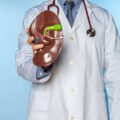Comment:
Despite its life-threatening effects, non-alcoholic steatohepatitis (NASH), the inflammatory subtype of non-alcoholic fatty liver disease (NAFLD), remains predominantly underdiagnosed. This is due to the paucity of NASH-specific therapies, clinical symptoms, and patient awareness. Moreover, despite their invasiveness and known complications, liver biopsies are the current gold standard to diagnose NASH. In this vein, non-invasively identifying and stratifying patients at high risk of developing NASH is a crucial endeavour.
This study aimed to evaluate the performance of NASHmap, a non-invasive machine learning model developed to identify probable NASH patients using 14 variables routinely collected in standard clinical practice. Analyses of its prediction accuracy were conducted in both general and at-risk populations.
Key learnings:
In a cohort of patients with and without biopsy-confirmed NASH, NASHmap possessed a positive predictive value of 81%. However, its sensitivity varied between 72% in a cohort with biopsy-proven NASH and 86% in NASH patients with type 2 diabetes mellitus (T2DM). Misclassification occurred within NASH patients with more subtle clinical changes, i.e., hepatic, metabolic, and inflammatory features closer to non-NASH patients. Similarly, false positives occurred in non-NASH patients with features similar to those with NASH. These errors further reflect the urgent need for sensitive parameters to effectively identify patients with marginal clinical profiles. Ultimately, however, NASHmap’s performance rationalises its implementation into clinical practice to improve specialist referrals.


Hepatic inflammatory responses in liver fibrosis